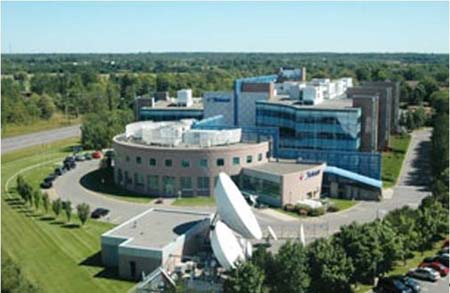
Newtec has announced that its modems have become the first to be successfully tested over-the-air on Telesat’s inaugural Low Earth Orbit (LEO) satellite.
Telesat’s Phase 1 LEO satellite was launched on January 12, 2018, and the company is now conducting live demonstrations of its capabilities. With the deployment of a global LEO constellation, Telesat hopes to revolutionise broadband communications around the world. Testing of the Ka-band payload is ongoing and Newtec’s technology is being used to demonstrate different service scenarios. The latest trials saw test user traffic successfully passed over the satellite via Newtec modems, showing that flawless operation without packet loss can be achieved on LEO constellations.
Newtec’s modems were installed for the project at Telesat’s Allan Park facility in September. Telesat expects to conduct live phase 1 LEO testing with its customers in the coming weeks. Telesat’s LEO constellation will combine the company’s global spectrum rights in Ka-band with Telesat’s proprietary LEO architecture to transform global communications. The constellation is designed to deliver a combination of capacity, speed, security, resiliency, latency and low cost, delivering affordable fiber quality connectivity everywhere. Once fully deployed, Telesat LEO will accelerate 4G/5G expansion, bridge the digital divide with fiber-like high-speed services into rural and remote communities, and set new levels of performance for commercial and government broadband on land, sea and in the air.
“Telesat is pleased to collaborate with high technology vendors such as Newtec to validate key performance aspects of our LEO system design. Our state-of-the-art LEO constellation will combine Telesat’s global spectrum rights in Ka-band with our proprietary LEO architecture to provide fiber-like broadband performance where terrestrial networks cannot reach,” commented Dave Wendling, Telesat’s Chief Technical Officer.
“This latest round of testing marks a significant step towards the future, showing that advanced modem technology, which works seamlessly with LEO satellites, is already available on the market today.”
According to Northern Sky Research (NSR), wholesale operator revenue from non-geostationary constellations, such as Telesat LEO, is expected to post a compound annual growth rate of over 40% during the next decade. The benefits of non-geostationary satellites include very high-throughput, service reliability, cost-effectiveness, low latency and overall superior broadband performance.
“LEO is a technology we watch closely, and we are pleased that our modems have been able to support Telesat on this important technology proof,” said Frederik Simoens, Chief Technology Officer at Newtec. “The testing process began with small-scale tests and we have been working our way up throughout the process, with these latest tests showing the potential of LEOs in efficiently and reliably delivering end-user traffic. Our modem portfolio, combined with next-generation on-board technologies, is ideally suited to bring maximum efficiency and throughput.”














Add Comment